
Nonprofit Marketing And Communications
Build a brand that moves people and a message that gets results. This collection of expert-led videos gives nonprofit leaders the tools to plan smarter, communicate clearly, and expand their reach across today’s fast-changing media, technology, and stakeholder landscape.
Learn how to position your mission with confidence, develop content that converts, drive engagement across platforms, and create campaigns that attract donors, volunteers, and advocates. These sessions explore everything from brand strategy and storytelling to social media, email impact, and data-informed marketing.
You’ll also gain guidance on internal communications and crisis messaging—so your team stays aligned, your board stays informed, and your organization remains steady when it matters most. Whether you’re refreshing your brand, launching a new campaign, responding to a challenge, or navigating the demands of digital visibility, you’ll find real-world insights and proven methods to amplify your voice and move people to action.
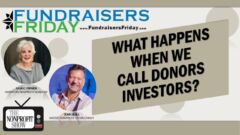
What if the people we call donors are actually investors? And what if this subtle shift reshapes expectations, power, professionalism, and even the identity of philanthropy itself? Julia C. Patrick and Tony Beall challenge one of the nonprofit sector’s most deeply rooted labels.
Julia opens the conversation by admitting she’s ready to change her own vocabulary, saying, “I’m going to really work hard to say investor, because I think you’re right—this is the way we need to go.” Her candor sets an energetic tone for a conversation that questions long-held nonprofit norms while encouraging fundraisers to rethink the relationship they build with contributors.
Tony expands on how much the terminology already shapes his practice. “It’s pretty much standard for me now to speak of donors as investors,” he explains, noting that while the marketplace may not fully be prepared for the switch, fundraisers can begin reframing relationships in ways that strengthen professionalism, transparency, and long-term engagement.
The conversation provocatively asks whether “donor” — rooted in the Latin donare, meaning to give — unintentionally implies release, relinquishment, or even detachment. Meanwhile, “investor,” drawn from investire, meaning to clothe or furnish power, places the contributor inside the organization’s journey, not on the sidelines.
From this vocabulary shift springs a lively exploration of expectations. A donor may hope the gift “does good,” while an investor wants measurable progress, long-term capacity building, and consistent communication tied to real results. That distinction pushes nonprofits toward better data, better systems, and better reporting.
Julia and Tony also discuss how this reframing could meaningfully influence recruitment and retention in the sector. Elevating the profession with language rooted in strategy and expectation — not charity alone — may attract more skilled talent while giving current fundraisers a clearer sense of the complex, meaningful work they perform.
They later explore generational dynamics. Older supporters may lean toward benevolence. Younger supporters are far more metrics-driven, tech-oriented, and impact-focused. For next-gen philanthropy, “investor” may simply feel more accurate.
The informative convo closes with a practical comparison using a $5,000 gift to a food bank. A donor experiences satisfaction and goodwill. An investor expects data: pounds of food purchased, households served, meals distributed. The contrast illuminates how terminology drives operational behavior.
By the end, the case for shifting language becomes both philosophical and functional. It’s a lens that prompts nonprofits to strengthen systems, build trust, and engage contributors more meaningfully — all while honoring the emotional roots of giving.
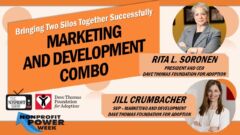
The Dave Thomas Foundation for Adoption shows exactly how today’s nonprofits can accelerate mission and amplify revenue by putting marketing and development on the same team! CEO & President Rita L. Soronen and SVP of Marketing & Development Jill Crumbacher explain how an approach that started 11 years ago matured into an integrated structure with shared goals, clear ownership, and board alignment. As Rita puts it, “there’s just this intuitive sense…that one feeds the other,” adding that the shift “became very much an organic, ongoing conversation based on results.”
Jill brings for-profit rigor to the model: a VP of Marketing and a VP of Development co-lead paired “mini teams” for every fundraising channel, tracked in Asana with crystal-clear metrics. “Building a brand builds fundraising and building fundraising builds a brand. It just does,” Jill says. She adds, “For every fundraising team, we have a marketing team that supports the fundraising team”—a simple but powerful mechanism that reduces friction, speeds execution, and raises standards across content, design, and segmentation.
Rita details how leadership benefits from unified messaging: presentation materials, program context, and donor narratives are synthesized by one group that also collaborates tightly with program staff. She emphasizes stewardship and brand guardianship: “we’re not just protecting the brand of children in foster care, we have Dave Thomas in our name… We’re protecting that brand as well,” including the Foundation’s decades-long partnership with Wendy’s. The conversation also takes on today’s polarized climate. “We’re putting resources into the effort of how do we bring polarized conversations back together?” Rita notes, reinforcing the Foundation’s focus on solutions that broaden support without losing mission clarity.
Talent development is intentional. Jill shares how their marketers attend the Lilly Family School of Philanthropy to learn fundraising dynamics, while fundraisers learn marketing language and channels—so both “come out of the same gate.” The approach scales: the department grew from a handful of staff to 25, roughly split between development and marketing, with half of marketing embedded on fundraising squads and half focused on awareness, brand, and sector thought leadership.
The result is a disciplined, collaborative culture that moves faster, communicates smarter, and raises more—while advancing permanency for children in foster care.
#TheNonprofitShow #Adoption #NonprofitLeadership
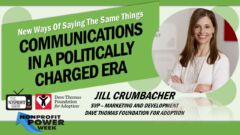
Nonprofits are being yanked into culture wars they never asked for. In this Nonprofit Power Week conversation, Jill Crumbacher, Senior VP of Marketing and Development at the Dave Thomas Foundation for Adoption, lays out how to keep your message steady when the public square gets noisy. This episode is a field manual for keeping your purpose intact—and your voice effective—when the temperature rises!
Jill’s team spans both marketing and fundraising—by design. As she puts it, the Foundation treats the whole enterprise “as one big communication strategy,” where audience segmentation, message discipline, and timing live in the same room.
Are foster care and adoption political? Jill’s answer: yes—and no. The Foundation operates at the back end of the process, after courts determine a child cannot safely return home. That’s where “finding forever families” becomes the mission—while the front end (why a child enters care) is where debates about poverty, racism, and systems flare. That nuance matters, and Jill’s team crafts language for each audience: “adoption” for the public; “permanency” for child-welfare professionals who also consider guardianship and reunification.
Jill’s playbook mixes discipline with restraint. She says it plainly: “Just because a reporter calls you doesn’t mean you have to reply.” Years before headlines heat up, her team works with crisis-comms experts to pre-write long and short answers for likely “arrows”—from Dobbs to immigration—paired with a decision tree about whether to engage at all. The goal is to protect mission focus when others try to conscript your voice for their fight.
Inside the house, rigor rules. The comms calendar is “beautifully organized chaos,” mapping channels, suppressions, and variants for donors (new, returning, Wendy’s-affiliated, etc.), followers, and child-welfare audiences. Message control isn’t censorship; it’s service to clarity. The team maintains a “say this, not that” lexicon and sends materials to outside reviewers to catch phrasing that could be misunderstood in other contexts.
There are also non-negotiables. “We will celebrate all children and we’ll advocate for all children in the system, regardless of how they identify,” Jill says. The Foundation’s images and words stay consistent year-round—they don’t “poke,” they persist. And when criticism pops up, they’ve seen the community often step in first, defending the work organically on social media.
If you steward a mission in a volatile moment, borrow these moves: define your lane, choose words precisely, prepare answers in peacetime, monitor hot-button issues for possible linkages, and decide in advance what you will never trade away.
#TheNonprofitShow #FosterCare #CrisisCommunications
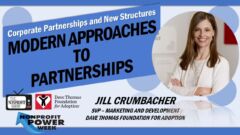
The Dave Thomas Foundation for Adoption doesn’t treat partnerships as a side project—they’re the operating system. During this National Adoption Month and in this Nonprofit Power Week kickoff, Senior VP Jill Crumbacher shares how the Foundation builds relationships that move from a good idea to real results. Step one: align the people doing the work. “Our marketing and our development practice is under one department that I lead,” Jill explains. That single team design means awareness and revenue aren’t competing—they’re collaborating—so a PSA, a billboard, a direct-mail test, or an influencer post can ladder up to the same mission outcome.
Jill dismantles the common myth that Wendy’s alone funds the mission. Wendy’s is a long-standing, values-matched partner, but the need—kids and teens waiting for family in the U.S. and Canada—calls for many hands. That’s why DTFA manages a wide mix of partners each year: micro-influencers and media outlets, cause-aligned brands, and fundraising collaborators. To keep everything clear and friendly, they start with the right agreement for the moment—an approachable MOU for brand exchanges and content support; a fuller contract when dollars or large placements are involved. The paperwork isn’t red tape—it’s a map. Who does what, by when, with what approvals. Everyone can move faster because expectations are written down.
Media is changing, and the Foundation adapts. Donated placements are still vital (think PSAs across billboards, airports, radio, and connected TV). But there’s also a growing middle lane Jill calls “low bono”—discounted inventory that isn’t free but is far below market. The team buys when the data says it’s smart, especially in digital, and pairs that with donated reach for scale.
Brand care is a shared responsibility. The Foundation reviews language and usage to protect its name and the Wendy’s connection. If something flares online, they pick up the phone so partners aren’t blindsided. That builds trust, and trust keeps doors open. Multi-year deals? They’re great when they make sense, but Jill’s team prefers to earn renewal through value rather than lock people in. The relationship stays fresh because both sides want to come back.
Maybe the most refreshing part is Jill’s take on celebrity. The organization has tested it; the results weren’t lasting. The real wins come from people and brands who show up because they truly care. As Jill puts it, “You go further with the ones that are organic… when you’re all in it about the mission.” Those partners bring energy, introduce new allies, and help the message travel farther.
If you’re rethinking how your organization shows up with partners—how you set expectations, share brand space, blend donated and paid reach, and keep everyone rowing in the same direction—this conversation is a ready-to-use roadmap for doing it well, and doing it together.
#TheNonprofitShow #AdoptionMatters #NonprofitPartnerships
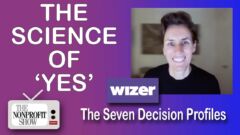
Nonprofits send more messages than ever, yet many still miss the moment that matters: the decision. The CEO and Co-Founder Kylee Ingram of Wizer Technologies explains how seven decision profiles can transform fundraising emails, stewardship notes, and board communications from “nice” to effective. If donor retention, board alignment, and major-gift outreach are priorities this year, this episode gives you the evidence-based path to communicate the way your audience actually decides.
Built from research originally advanced by Juliette Bourke (author of Which Two Heads Are Better Than One?), Wizer’s framework maps the way people actually choose—across seven profiles: Achiever, Analyzer, Collaborator, Visionary, Explorer, Guardian, and Deliverer.
As Kylee puts it, “What we’ve created is a program called Wize Snaps… it will look at your comms and then live replicate and tell you what’s right and wrong about it—then generate a new email based on that person’s decision profile.” The fix isn’t creepy personalization (“How’s your dog?”). Its decision-relevant signals and templates tuned to how people weigh evidence, risk, outcomes, process, and options. Inside organizations, keeping cognitive diversity matters, too; when teams mirror top leadership styles, innovation drops, and decision errors rise!
Kylee also speaks to what’s in the playbook for 2026: AI can shorten drafting time, but message-market fit still wins. “AI helps people write better… It’s not helping you write the right message necessarily,” Kylee says. Her counsel: slow down, identify the decision profile, and then scale. Use visuals and A/B testing with intent: for some profiles, a results graph will outperform a cute animal photo; for others, a clear process step-down or risk-mitigation note unlocks action. Start inside your nonprofit—board and staff—so your culture and donor experience align.
Wizer offers free full decision profiles for teams and boards, plus Wize Snaps to assess copy and suggest rewrites.
#TheNonprofitShow #NonprofitMarketing #FundraisingStrategy

We sat down with Amos Balongo, keynote speaker and communications coach, to explore a subject rarely discussed in the nonprofit space — personal visibility. Amos challenges the traditional mindset that humility and impact must exist in separate spheres, proposing instead that visibility is both a professional asset and a form of leadership.
Speaking from Honolulu, Amos sets the stage with a simple truth: “If you don’t speak for your work, nobody else will.” His message resonates deeply within a sector that often prizes quiet service over self-advocacy. For Amos, visibility isn’t vanity — it’s strategy. He reframes communication as the ability to connect and insists that becoming visible is a learnable habit rather than an innate gift. “It’s not hope; it’s a strategy,” he says. “You have to be bold, brief, and strategic.”
Show host Julia Patrick draws the connection to the real-world nonprofit landscape, where professionals work tirelessly to amplify their organizations while neglecting their own personal brands. The result, Amos explains, is that talent often remains unseen. Visibility, he emphasizes, begins with intentionality — knowing your stakeholders, communicating outcomes instead of effort, and building recognition across and beyond your nonprofit.
Amos’s philosophy merges clarity with courage. He invites nonprofit leaders to reject the old adage “let your work speak for itself” and instead cultivate everyday visibility — a daily practice of sharing progress, celebrating results, and speaking with confidence. He notes that humility isn’t silence; it’s authenticity. The key is to shift from describing how hard you’ve worked to explaining the difference your work has made.
Networking, too, takes on new meaning. Rather than collecting business cards, Amos urges purposeful connection rooted in belief, preparation, and authenticity. “Networking is an inside job before it becomes an outside job,” he asserts, reminding listeners that confidence in oneself and one’s mission radiates outward.
Ultimately, this conversation transcends self-promotion. It’s about alignment between who you are and how you are perceived — an integrity-driven approach to leadership. Visibility, Amos concludes, is not a one-time project but a lifelong habit, built daily through connection, clarity, and courage.
#TheNonprofitShow #LeadershipVisibility #NonprofitBranding
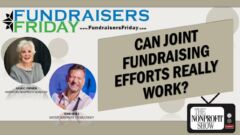
Joint fundraising: bold idea, complicated feelings. On this Fundraisers Friday, Julia C. Patrick and Tony Beall swap real-world stories and field notes on how small and midsize nonprofits can team up without tripping over turf, lists, or logistics. Julia sets the table with a grin—“They’re super tricky, they’re very interesting, and I think there’s a lot of fear around it”—then Tony gets granular on where collaboration actually shines: events. Think shared strengths: one NPO’s marketing mojo plus another’s room-flow wizardry equals a stronger guest experience and better net for all.
The throughline is alignment. Serve the same community—youth, seniors, cancer journeys, pets—so the purpose reads as one chorus, not competing solos.
Contracts keep friendships friendly. Spell everything out in an MOU (Memorandum of Understanding) or partnership agreement: shared costs, who fronts deposits, marketing responsibilities, volunteer management, night-of logistics, and—vital—who’s the fiscal agent. As Tony puts it, “It’s just a reminder that we are running a business.” Marketing lists stay private; attendee lists can be shared with explicit consent at registration. Afterward, leverage an event page for social recaps while each org pushes post-event notes to its own supporters.
Courage shows up at the recap table. Schedule a quick postmortem to capture wins, gaps, and “never again” insights while memories are fresh. Sometimes the bravest answer is one-and-done: celebrate the success and move on. Julia’s take on reality checks lands with a smile and a nod to capacity: big hearts are fantastic, but bandwidth pays the bills!!
#TheNonprofitShow #NonprofitFundraising #Collaboration
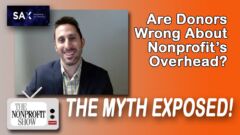
The phrase “overhead myth” still haunts the nonprofit world like a stubborn ghost. Host Julia C. Patrick sits down with Adam Holzberg, Partner and CPA at SAX Advisory Group, to teach viewers why judging nonprofits by their administrative expenses misses the point—and how education, transparency, and storytelling can replace outdated thinking with real understanding.
Adam defines the myth plainly: “It’s the idea that a nonprofit is less effective when it has higher overhead.” That assumption, he stresses, is simply untrue. The salaries, training, technology, IT support, and finance work that make up overhead are the very systems that keep programs running effectively. Yet donors and watchdogs still cling to the notion that only direct program spending matters. “In reality,” Adam says, “those programs can’t even function without this infrastructure behind the scenes.”
He traces the myth’s roots to the early days of charity watchdogs comparing organizations through the functional expense schedule on Form 990 filings. Those comparisons turned rough accounting estimates into moral judgments, and the damage stuck. Many nonprofits still feel pressure to brag about low overhead ratios—even when it hurts them.
Adam teaches that context matters. A government-funded nonprofit may appear more efficient because it spends little on fundraising, while a community charity that relies on individual donations will show a larger overhead percentage. There’s no universal benchmark—though watchdogs like Charity Navigator often cite 70 percent program spending as a target. But he cautions against treating that as a rule: every mission, funding model, and cost structure differs.
When asked how to fix the problem, Adam emphasizes education. Nonprofits must explain why investing in staff well-being, technology, and cybersecurity protects impact. His analogy brings it home: “If you build an offense with Patrick Mahomes and top receivers but neglect your offensive line, your team won’t move the ball. Nonprofits are the same—without infrastructure, even the best programs fail.”
Julia and Adam agree that shifting focus from expense ratios to impact data is the next frontier. Impact storytelling shows outcomes numbers can’t: lives changed, communities strengthened, futures rebuilt. Leaders, boards, and funders must learn to read those stories alongside the spreadsheets.
The conversation closes with hope—and a reminder that every conversation helps rewrite the narrative. By teaching donors, boards, and staff that strong infrastructure equals stronger mission delivery, nonprofits can finally end the burden of the overhead myth.
#TheNonprofitShow #NonprofitFinance #OverheadMyth
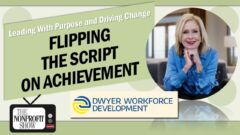
Dwyer Workforce Development is rewriting what “possible” looks like for a young, fast-scaling nonprofit. In this compelling conversation, CEO Barb Clapp traces a journey that began with a blank slate in September 2022 and now stands at 10,000 Dwyer Scholars across seven states—with a confident path to 100,000 by 2030. The spark came from founder Jack Dwyer’s twin commitments: expand opportunity for people shut out of stable careers and respond to the nationwide healthcare staffing crisis. Barb’s charge was bold—design a national model that moves quickly, performs consistently, and proves its value to partners, employers, and learners.
Her answer blends entrepreneurial rigor with social mission. Dwyer built a social enterprise engine—a $590 million conversion of a skilled nursing portfolio to nonprofit ownership—whose proceeds help fund training pathways. At ground level, the organization relies on clearly defined referral, training, and employer partnerships, each governed by MOUs and measurable expectations. That clarity enables adaptation to rural, suburban, and urban markets while maintaining one brand, one message, and one standard for outcomes. As Barb puts it, “My little motto is that press brings opportunity and having a consistent brand and understanding consistent messaging will improve outcomes.”
Communications discipline is not a tactic; it is strategy. Internal messaging aligns every team member on values, goals, and voice. External messaging earns trust, investment, and momentum. Boards and leaders who resist marketing spend, Barb notes, miss the compounding returns of consistent communication. The results are striking: rapid state expansion, strong completion and placement outcomes for scholars, and a repeatable market entry framework. States now approach Dwyer—Kansas and New York among them—because the model is explicit, execution-ready, and partnered from day one.
Barb’s leadership philosophy centers on kindness through candor. “Clarity is kindness… I’m like a street shooter, so no one really doesn’t understand what my expectations are.” That stance dignifies partners and scholars alike, and it fuels the organization’s capacity to scale technology, staff, and regional structures without losing its heart. The pandemic exposed both the fragility and heroism of healthcare work; Dwyer’s model honors that reality by opening doors to CNAs and other caregiving roles for individuals overcoming homelessness, domestic violence, and generational limits.
The takeaway is simple and ambitious: when mission meets enterprise discipline and brand coherence, systems begin to shift. Dwyer Workforce Development is proving that national growth and local responsiveness can move together—one clear message, one rigorous playbook, and thousands of new careers at a time.
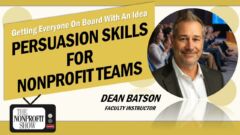
Nonprofits don’t just need more messages—they need messages that move people. In this fast-paced episode we welcome persuasion instructor and longtime marketer Dean Batson to show how science-based communication turns attention into action. Batson traces his path from launching a digital agency to teaching persuasion at Arizona State University, where he studies the shortcuts our brains use to decide fast. “We make mental shortcuts all day long,” Dean explains. “If you know which way someone may lean because of a heuristic, you can frame your message to nudge that choice.”
He breaks down social proof (those 5,000 five-star reviews that quietly sway your click), the danger of choice overload (the famous jam study where 24 flavors crushed sales), and the “availability heuristic”—why the word “shark” grabs attention while “falling coconuts” doesn’t. Dean’s advice: be the message people recall first. “Be the shark messaging, not the coconut messaging.”
For fundraisers, this means streamlining every pathway from interest to gift. Keep donors in System One (fast, intuitive) rather than forcing System Two (slow, effortful) that stalls giving. Less friction. Fewer steps. Clear next action. Dean contrasts persuasion and manipulation with a simple rule: persuasion is transparent and win-win; manipulation is opaque and win-lose—and it burns trust.
He also flips how teams read results. Many obsess over the 7% who opened an email while ignoring the 93% who didn’t—classic survivorship bias. The fix: study the non-responders and reframe your outreach so more people move. Dean offers practical tactics you can use today, like priming stakeholders with a short Slack note before a meeting to set the idea as the front-runner. And don’t wait: start shaping next week’s “yes” with simple, steady cues today.
Finally, Dean urges leaders to equip the entire organization—not just gift officers—with persuasion skills. When every staffer can frame ideas clearly, your mission becomes the message people remember, share, and support.
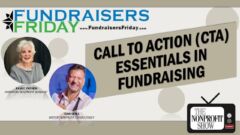
If you want donors to move, tell them exactly where to go. In this Fundraisers Friday conversation, Julia C. Patrick and Tony Beall turn vague appeals into precise, energizing calls to action (CTA’s)—across giving, events, engagement, volunteering, and advocacy. Tony lays the foundation early: “Start with the call to action. What do I want folks to do?” When you begin with the outcome, every sentence supports momentum, not meandering.
Julia puts a common myth on the table: “It’s not just like go out and ask a bunch of rich people for money.” Fundraising isn’t speed-dial; it’s relationship-building, timing, and clarity. Tony reinforces the point: “Fundraising is all about relationships,” and your CTA is the moment you convert relationship energy into tangible next steps—give, register, share, join, or contact.
Time-bound CTAs matter. Use real clocks, not artificial pressure. Matching gifts? Set the deadline: “Donate by October 15 so your gift will be doubled.” Community emergencies? Be specific: protect 20 roofs, feed families during power loss, or restore safe access to services this week. Impact framing turns abstract dollars into visible outcomes: $50 feeds one student for a month—$100 feeds two. That clarity invites bigger gifts because supporters can instantly see scale.
Equally important: truth and fit. If the amount and impact don’t match, supporters feel it. Build your figures from real program data, and keep the language human. Julia adds a practical lens for events: swap “RSVP” for action-forward phrases like “Save my seat.” Tap joyful FOMO without panic. Want engagement? Ask for it. “Click subscribe,” “Invite 10 friends,” “Share with a neighbor adopting a pet.” Want volunteers or in-kind items? Say exactly how to respond and how you’ll make it easy.
Advocacy belongs in your CTA toolkit too. This isn’t about politics—it’s about mission. Invite your community to “Stand with families—email your legislator today to support…” Frame the request around the people you serve and the outcome your programs create.
Finally, close the loop with gratitude-based storytelling. Julia’s favorite “Because of you” CTA wraps action and appreciation into one cadence: Because of you, 50 students received laptops; because of you, seniors got meals during outages. That framing reminds supporters they are the hero—today and tomorrow.
Start with the action you need, frame it with authentic impact, and invite your community to step forward—now.

Donor communication isn’t a seasonal chore—it’s the garden you tend all year. In this lively conversation, James Misner, Founder & Owner of The Kipos Group (Greek for “garden”), shows how consistent, human-centered messages keep supporters engaged, confident, and eager to act. His opening frame is memorable: schools send multiple reminders for an early bus drop-off because people are busy; nonprofits should be just as persistent—thoughtfully. As James says, “You should not be afraid to reach out to your donors… they need you to serve them by communicating frequently.”
James introduces a practical “trust triangle”: organization, leadership, and impact. Rotate your content so supporters see a stable organization with real stories, a visible and thoughtful leader, and outcomes that are tangible. Variety matters—mix email, social, mail, live streams, and short videos so people meet you where they already are.
He’s blunt about retention. Too many nonprofits don’t know their number, and the sector average still hovers around mid-40%. Causes of lapse you can’t control (life events) exist, but others are absolutely in your hands: saying thank you promptly and showing outcomes clearly. “If you do that, and that alone, and you do that regularly, your donors are going to stick with you.” James shares a jaw-dropping example of unthanked five- and six-figure donors—proof that basics move mountains.
To win in today’s attention economy, flip the script: make the donor the main character. Replace “we did X” with “you made X possible,” pairing metrics with meaning. Anchor stories in universal emotions (worry, hope, pride, relief) so even complex issues feel relatable. Segment when useful, but never lose the thread of human feeling.
James also adapts classic business wisdom for fundraising: keep donors, invite them to bring friends, grow generosity without eroding trust, and operate efficiently. The math is compelling—modest retention gains transform budgets, especially under $1M. The mindset is calmer, too: breathe, be thoughtful, and show up regularly with messages that serve.
Bottom line: water the garden weekly. Use stories, data, leadership voice, and channel variety to build trust. Put the donor at the center, thank quickly, report outcomes often, and watch retention—and impact—bloom.
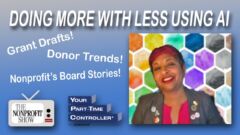
AI isn’t a magic wand—but it can absolutely help nonprofits do more with less when you understand what it is, where it fits, and how to use it wisely. In this energizing conversation, technology associate and CPA Christine Chacko from Your Part-Time Controller (YPTC) explains the practical difference between automation and AI, when to use each, and how to keep data safe while you experiment and learn. As Christine puts it, “AI is actually a form of automation,” but it handles open-ended, judgment-heavy tasks while traditional automation follows clear, narrow rules. Think rules for categorizing expenses (automation) versus analyzing trends, benchmarking, and surfacing insights across donor segments (AI).
Christine offers real nonprofit examples: blend automation to roll up donor data by type, then ask AI to interpret changes year over year, spot seasonality, or flag post-pandemic shifts. She shows how AI shines as a writing helper—drafting grant narratives tailored to funders’ preferences or condensing verbose copy into crisp executive summaries—while reminding us to review outputs for voice, accuracy, and appropriateness. “We really like to think of it as a thought partner,” she says, perfect for bouncing ideas, testing messages, and clarifying complex financial stories for boards.
Security matters, too. Christine’s guidance is simple and strong: read the fine print, know what you opt into, and understand the difference between models embedded in trusted systems and those that reach out to other tools. She introduces agentic AI—systems that can act on your behalf (e.g., access Outlook, browse the web, schedule emails)—and explains why permissions, policies, and internal controls must come first. Hallucinations are less frequent in newer reasoning models, but review remains essential—especially for grants and external communications where stakes are high.
Finally, Christine maps the near-term horizon: expect broader, more accessible agentic AI inside finance, IT, customer support, and daily workflows. Success won’t come from tools alone; it comes from culture—clear use cases, communication, training, and solid processes. Used well, AI reduces drudgery (transcripts, notes, routine emails) so nonprofit teams can focus on judgment, relationships, and mission results.

Social media strategist, author, and TEDx speaker, Robin Nathaniel, unpacks the connection between human relationships and digital platforms. With fresh ideas and candid energy, Robin introduces his SYNC Method—a framework designed to help nonprofits create authentic, meaningful engagement online.
Robin explains, “S is for simple. Messages you can say in four words—don’t say in twenty. Don’t overcomplicate your story.” He challenges organizations to focus less on technical jargon and more on clarity. The “Y” stands for Yield—yielding to intention. Instead of just pushing events, campaigns, or donation requests, he urges nonprofits to ask themselves what feelings and actions they want their audiences to experience before hitting “post.”
“N” is for Natural. Too often, Robin points out, organizations spend hours in the “makeup room,” worrying about lighting, graphics, and backgrounds. Instead, he recommends the “best friend test”: write and speak in a way your closest friend would understand. Finally, “C” is for Change It Up. Social media is not a box-checking exercise. Robin stresses adaptability: experiment, reset, and test new content approaches as platforms evolve.
Nonprofits often overwhelm supporters by blasting out too much information at once. Robin’s framework offers a more human and sustainable way forward. He also adds a crucial reminder: “The real measure isn’t clicks or conversions. It’s how you improve the lives of the people receiving your content.”
The conversation takes a deeply personal turn when Robin shares his Joy Audit, developed after the tragic loss of his brother. By redefining his life through the lenses of Create, Connect, and Contribute, Robin discovered how to realign time and energy toward purpose—linking directly to nonprofit burnout, recognizing how leaders often wear multiple hats without space for renewal.

Online giving isn’t just the future of fundraising—it’s the now! Emily Kelly, National Accounts Manager at Bloomerang, delivers a practical, energizing roadmap for nonprofits to raise more money online—without adding more stress to already full plates.
This conversation is for any nonprofit ready to increase online giving, improve donor retention, and strengthen relationships in a digital-first world. Emily blends practical “fix it today” steps with a bigger vision for creating donor experiences that inspire giving, year after year.
Emily’s passion for relationship-building is woven through every tactic she shares. With a background in marriage and family therapy, she sees fundraising not as transactions, but as an opportunity for deeper human connection. “The power of please and thank you is so much more powerful than anything else,” she begins—a reminder that technology should serve relationships, not replace them.
Her first piece of advice is deceptively simple: make sure your donate button works. Too often, organizations overlook this basic step. Then, view your donation page through the eyes of a first-time visitor—would you feel compelled to give? Is it clear, inviting, and emotionally engaging? Placement matters too. The donate button should be easy to spot, ideally at the top of your page, without forcing visitors to search for it.
Emily urges nonprofits to offer multiple payment options—credit/debit cards, Apple Pay, Google Pay, ACH, and even Venmo—to meet donors where they are. Each generation prefers different tools and limiting payment methods risks losing potential gifts.
She also challenges organizations to reimagine the donor experience for online gifts. Segmentation is key—tailoring acknowledgments by gift size, donor type, or relationship history. A generic thank-you isn’t enough; donors want to feel seen and valued. Communication preference tracking—whether donors prefer email, phone, text, or snail mail—helps build authentic connections and increase retention.
And yes, the old-fashioned phone call is making a comeback. Emily shares research showing that calling a first-time donor within 24–48 hours makes them four times more likely to give again. Whether done by staff, volunteers, or board members, these calls create goodwill on both sides—reigniting board member engagement while deepening donor trust.
Emily’s philosophy is clear: treat every gift, whether $50 or $50,000, as the start of a relationship. One-time gifts can become long-term commitments—or even legacy gifts—when nonprofits follow up with gratitude, intentionality, and consistent communication.
